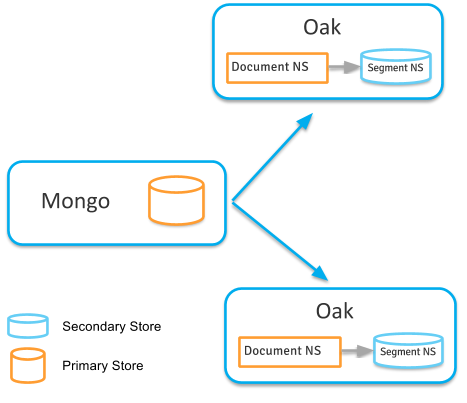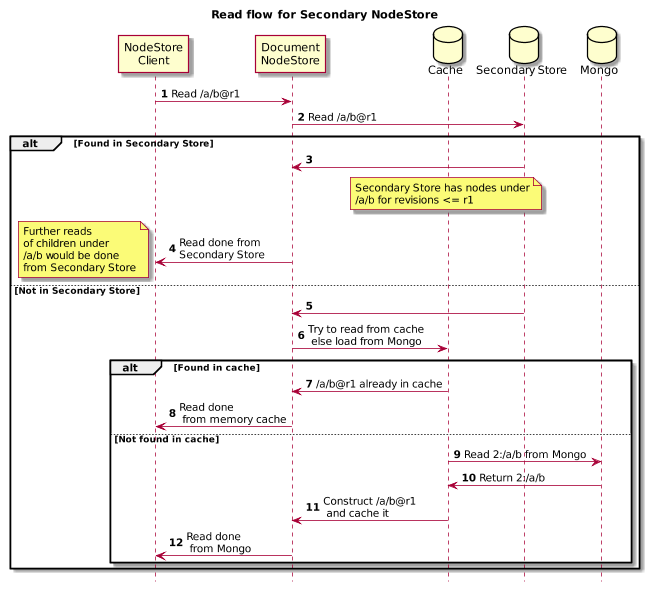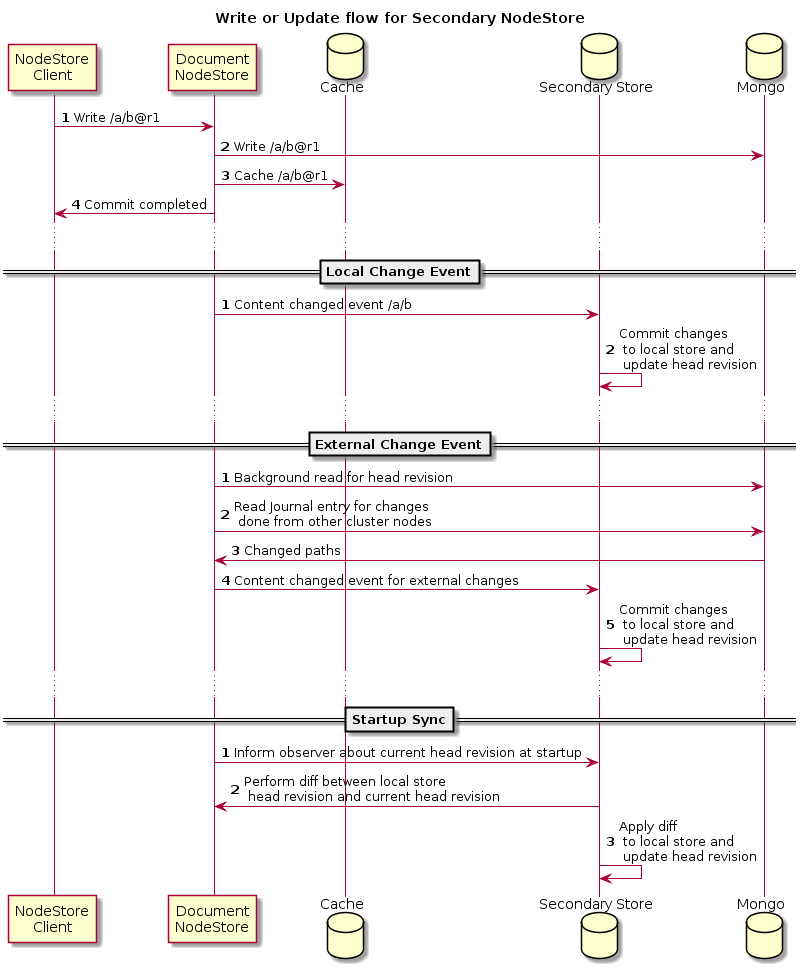Secondary NodeStore
@since Oak 1.6
Experimental Feature
Compared to SegmentNodeStore DocumentNodeStore has higher latency for reads for the data not present in the cache. This happens due to multiple round trips required to serve a hierarchical read access over remote storage. For e.g. reading content of path /content/assets/nature/sunrise.jpg would require around 4 remote calls if the path content is not present in local cache. Persistent Cache helped in improving this by enabling caching lot more content off heap compared to limited inmemory cache.
With new Secondary NodeStore support its now possible to configure a SegmentNodeStore as a secondary store to store content under certain set of paths locally. SegmentNodeStore act a local copy of remote repository (secondary store) more like a local git repo which gets updated from primary store (remote Mongo storage) via observation. Writes are still routed to primary store but reads can be served from local secondary store.

In above setup 2 Oak Cluser nodes connect to same Mongo server. In each Oak instance a SegmentNodeStore is configured as secondary store. This store gets updated by observer.
Experimental Feature
This feature is currently experimental. Following feature item is currently pending
- OAK-5352 - Support for maintenance task for secondary NodeStore
Read Flow
Reading /a/b at revision r1 would happen like below

Key points here
- Secondary NodeStore can be configured to only stored content under certain paths
- Read would be first attempted from any configured secondary NodeStore.
- Secondary NodeStore would check if it stores content for that path. Note that it can be configured with path inclusions
- It then checks whether its root revision is later than revision at which read is being requested
- If NodeState at given path and revision is found then its returned
- If read is not possible from secondary NodeStore then read is done from in memory which may in turn read from remote Mongo in case of cache miss
- If read is successful from Secondary NodeStore which is based on SegmentNodeStore then further child read from that path would be directly handled by SegmentNodeStore by passing DocumentNodeStore altogether. So if /a/b@r1 is found in secondary then read for /a/b/c@r1 would be directly handled by secondary store
Note that even if root revision of secondary store is lagging behind current head its possible that read for /a/b can be handled by secondary store if /a has not been modified recently. So those parts of repo which have not been recently modified would most likely be served from Secondary NodeStore and avoid remote calls to Mongo.
Write Flow
Updates to secondary store happen in 3 ways

Key points here
- Writes done by NodeStore caller i.e. JCR layer are always done on primary store i.e. Mongo
- Secondary NodeStore is updated via Oak Observation support and NodeState diff
- Secondary NodeStore can be configured with path filter and then it would only be interested in changes for configured paths
Local Changes
For local changes done on that cluster nodes the writes are applied as part of Observation call where DocumentNodeStore send content change callback to all registered observers. Here Secondary NodeStore registers itself as an Observer and listed for such callback.
So upon any local change it gets a callback with latest state of root paths. There it performs a diff between local head revision and new head revision and applies the changes onto local store
External Changes
DocumentNodeStore periodically performs background reads to pickup changes from other cluster node. Such a change is then pushed to registered observer as an external change. Secondary NodeStore uses same flow as for local changes to update its state.
This diff based update mechanism would then only read content from remote for the changed paths and further only for paths in which secondary NodeStore is interested
Startup Sync
If the cluster node is shutdown and later started then at time of start the secondary NodeStore would try to synchronize its state with remote storage again by performing diff between local head revision and remote head revision. This is done asynchronously and does not block the startup
Setup
For enabling this feature following OSGi configurations have to be done
1. Configure SegmentNodeStore in secondary role
Create an OSGi config file org.apache.jackrabbit.oak.segment.SegmentNodeStoreFactory-secondary.config with following
content
role="secondary"
This would create a SegmentNodeStore in secondary role and uses default segmentstore-secondary directory to store
the segment files. Refer to config options for more details.
Note all the options for SegmentNodeStoreService are applicable for SegmentNodeStoreFactory
2. Configure SecondaryStoreCacheService (optional)
By default secondary NodeStore would be activated based on previous config only. However it can be tweaked further
by creating an OSGi config file org.apache.jackrabbit.oak.plugins.document.secondary.SecondaryStoreCacheService.config
includedPaths=[ \
"/libs", \
"/apps", \
"/content"
]
Above config would enable secondary NodeStore for paths ‘/libs, /apps and /content’
Setup Considerations
While enabling secondary NodeStore feature following aspects needs to be considered
- SegmentNodeStore used as secondary NodeStore would compete with system resource like memory along with in memory caches of DocumentNodeStore and Lucene index files. So system must have sufficient memory to for all these 3 components
- SegmentNodeStore can be copied from any existing cluster node to a new node.
- If this is being enabled for existing setup then initial sync would take some time. So take that into account while planning to enable this feature
- For best performance include those paths of the repository which are accessed by end user. Specially those content paths where read to write ratio is high.
Administration
Maintenance
Certain maintenance like online RevisionGC for secondary NodeStore i.e. SegmentNodeStore need to be enabled. (This feature is currently pending OAK-5352).
This would ensure that older revision gets garbage collected
New Cluster Member
If a new Oak server is joined to cluster then it should be done by cloning the secondary NodeStore from some existing cluster member otherwise the initial sync would take a long time to complete


